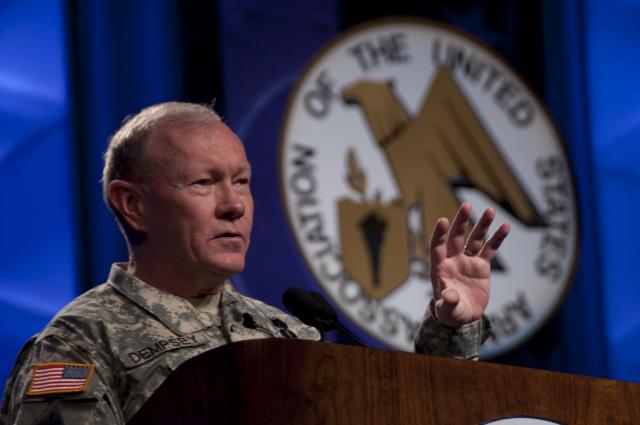It’s time for the Army to reverse gears after 10 years of war, said the service’s leading proponent of training and doctrine.
Gen. Robert W. Cone, commander of the U.S. Army Training and Doctrine Command, spoke Thursday about “shaping the Army of 2020.” As keynote speaker at the Association of the U.S. Army’s Aviation Symposium dinner, he explained the terms “expansibility “and “reversibility.”
When the Army expanded to meet wartime needs in Iraq and Afghanistan, it mobilized TRADOC Soldiers and replaced them at the training centers with quality contractors and civilians, he said.
Now that the manpower needs in theater are beginning to drawdown, he said “reversibility” must prepare the Army for the next war through a focus on full-spectrum training.
“The Army has evolved to an understanding of counterinsurgency,” Cone said, but “does not understand the high spectrum of operations.”
Preparing for the next war simply by studying Iraq and Afghanistan would be a mistake, he said. The next conflict might be quite different.
Earlier in the day, Cone had been at a “Unified Quest” seminar in Potomac, Md. More than 90 warfighters, interagency experts and foreign officers were attending a three-day seminar to determine how the Army of 2020 should fight as part of a joint force.
It was the fourth Unified Quest seminar in six months as part of the Army chief of staff’s challenge to identify issues and opportunities that will test the force of the future.
The Middle East will likely continue to be an “Army-centric theater of operations” for years to come, Cone said. However, the administration is now placing more emphasis on the Pacific and Asian theaters, he added.
Emphasis in the Army needs to be on more than just deploying every other year, Cone said.
“We are an Army that values experience almost exclusively at this point,” he said. Now there’s a challenge to promote TRADOC assignments, fellowships and graduate school to round out leadership development, he added.
“My greatest fear is losing this great generation of warfighters that has done so much for us for the last ten years,” Cone said.
Training must be realistic, he said. Scenarios should not go back to fighting “Krasnovians” and fictional forces, he said, and he advocated focusing on possible real-world adversaries. Brigades in the states can each be aligned with a real-world contingency, he suggested. There’s a “whole sweep” of virtual training that units can do at home station, he said.
On the other hand, Cone said he doesn’t expect leaders today to read the Army’s entire inventory of 500 manuals. He said there’s a push now to trim field manuals down to just 10 or 11 pages and put more information online. He termed this as part of a trend to “wiki-ize” doctrine.
“Manuals should be written by the guy with the hottest hand coming back from Afghanistan,” he said.
It’s also time to restore brigades to three maneuver battalions, Cone said. For some time, a number of brigade combat teams have been operating in theater with only two maneuver battalions. A recommendation is now before the Army secretariat to restore the three-battalion brigade, Cone said.
More engineers should also be restored to the BCTs, Cone suggested. Less mature theaters will need more combat engineers, he emphasized. And everyone who has served in the last 10 years knows the value of Army aviation, he added.










